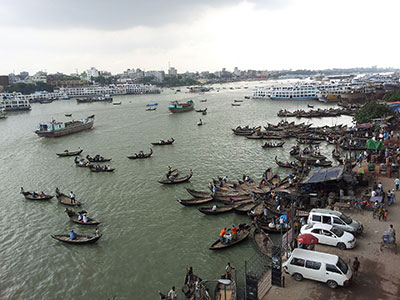Bangladesh's Climate Change Challenge
Ashley Johnson (NBR) discusses three heavily emphasized concerns expressed by policymakers in Bangladesh—disaster relief, community stability, and food security—and some of the proposed methods to adapt to the impacts of a changing climate.
In January, U.S. secretary of defense James Mattis articulated the case for viewing environmental and national security as interrelated, arguing that “the effects of a changing climate—such as increased maritime access to the Arctic, rising sea levels, desertification, among others—impact our security situation.” [1] This argument has long been accepted by many scholars and governments alike and has been acknowledged as a key reason behind many national plans to combat climate change. One country that has recognized the destabilizing potential of climate change and the urgent need to increase international cooperation to address its impacts is Bangladesh.
Bangladesh accounts for only 0.35% of global emissions yet is particularly susceptible to the risks imposed by a changing climate. [2] Ongoing domestic efforts to manage this security threat have largely focused on adaptation rather than mitigation. The primary concern for policymakers is to strengthen capacity building and limit instability in a country of approximately 157 million citizens. Most of Bangladesh sits at an elevation of just a few dozen feet above sea level, and the southern delta region, which is positioned even lower, is home to approximately 35 million people. The country also has one of the highest population densities in the world, with about 1,000 people per square kilometer (km). [3] This confluence of factors has brought adaption efforts to the forefront of policymaking agendas.
Stakeholders—ranging from development banks and NGOs to both city and national governments—are taking action to address the many challenges imposed by climate change. In 2016 the Energy, Resources and Environment Program at the Johns Hopkins University’s School of Advanced International Studies sponsored a research trip to Bangladesh to explore climate change adaptation policies. [4] This commentary discusses three prominent concerns—humanitarian assistance and disaster relief, community sustainability, and food security—and highlights several solutions proposed by stakeholders. [5]
Humanitarian Assistance and Disaster Relief
Approximately 75% of cumulative global casualties from tropical storms have occurred in three of the countries bordering the Bay of Bengal—India, Bangladesh, and Myanmar—with Bangladesh accounting for the majority of these losses. [6] In 2007, Cyclone Sidr was one of the most devastating natural disasters the country has seen—more than 4,000 people died, 95% of rice harvests in coastal regions were lost, and $1.7 billion in damage was inflicted on the population. [7] In addition to cyclones, other natural disasters such as monsoon flooding and landslides pose threats to unprepared populations. More than 160 people were killed in a landslide earlier this year as a result of overdevelopment on eroding land, and the recent flooding in August killed more than 140 people.
The international donor–supported Bangladesh Climate Change Resilience Fund (BCCRF) has played a major role in implementing programs that address this challenge. The BCCRF was allocated $189 million for afforestation projects, cyclone shelter construction, and improvements to embankments and dykes. The World Bank has additionally consulted with the Ministry of Environment and Forests about utilizing afforestation to improve 250 square km of coastal areas such as the Sundarbans, as plant life slows the progress of the storm and flood waters. Over 5,000 km of coastal and river embankments, which face constant erosion from normal monsoon rains and cyclone flooding alike, have been rebuilt with help from the BCCRF.
Several government ministries have also focused on constructing multipurpose cyclone shelters, which not only provide a stable structure during storms but also serve as schools or other community buildings under normal weather conditions. Despite the addition of 2,500 shelters in recent years, many people are reluctant to leave their homes due to concerns over the theft of belongings that are left behind. In response, the government has also been assisting communities by elevating homes so that they are not completely swept away by storm surges. The Cyclone Preparedness Programme has been a key tool for stakeholders. The program not only provides communities with an early-warning system for impending disasters; it also helps educate residents on best practices for evacuation, emergency healthcare, and risk reduction. For many policymakers, education will continue to be a major tenet of their efforts to increase capacity building in the country.
Community Sustainability
Although sea levels in Bangladesh only rose at a rate of seven millimeters a year on average from 1980 to 2003 (for a total of six inches), the World Bank, UN Environment Programme, and others have forecasted much higher levels in coming decades. [8] The Intergovernmental Panel on Climate Change has additionally estimated that 20 million people will likely be displaced in the next five years due to rising sea levels. [9] Bangladesh is already experiencing this trend, with more than 400,000 people moving to Dhaka each year due in part to land loss and disappearing economic opportunities in the southern region. As a result, improving living conditions in the delta, even if for a short period of time, is a priority.
One approach taken by government stakeholders and development organizations is the refortification of houses so that communities do not have to relocate as often. This process can be as simple as raising the foundation of homes so that they are more resistant to encroaching tides and floods. The Ministry of Environment and Forests also promotes the use of floating beds (mats woven from banana tree leaves laden with soil), which allow people to grow crops over water. This initiative aims to utilize both the increased water cover and saline-resistant crops to maintain levels of agricultural production. Floating beds may also be used in ponds and streams in urban areas to provide sources of food to climate and economic migrants. These two adaptation tools are notably only short-term solutions to a long-term problem, but they allow people to remain in their homes longer and continue earning income from the production of food.
Agriculture and Food Security
As recently noted by the Asian Development Bank and World Bank, rising sea levels in the Bay of Bengal have resulted in the infiltration of saltwater into Bangladesh’s freshwater supply, with adverse effects on agricultural production. The poorest populations in the coastal regions, which number approximately four million people, already lack sufficient freshwater for agriculture and general consumption, and this figure could double by 2050 if no actions are taken. [10] This issue is not only a concern for coastal dwellers; a local government official stated that salinity will likely reach Dhaka’s water supply by 2050, tainting freshwater resources. [11]
More than 87% of rural households rely on agriculture for at least part of their income, and increased agricultural yields have played a major role in reducing poverty levels. [12] Over the course of the past decade, however, farmers have experienced an average reduction of 80 kilograms in rice yields, as well as the loss of sugarcane, jute, and some oilseed crops due to increased salinity. [13] Continual reduction in crop yields could result in a 15% increase of those living in poverty by 2030. [14]
The Bangladesh Rice Research Institute (BRRI), an autonomous branch under the Ministry of Agriculture, began tackling the problem of food insecurity through the cultivation of saline-resistant crops in 1973. However, as the situation becomes more severe, the government has increased its partnership with academic institutions, NGOs, and other organizations, including USAID, to develop and disseminate more resilient crop varieties. A team of Bangladeshi scientists from the Bangladesh Rice Research Institute and Dhaka University developed four transgenic rice varieties that yield 50% more than seeds that were conventionally bred. [15] Pending successful trials, two of these strains may be widely accessible within the next two years. USAID has also been working with Bangladeshis to develop climate-prediction models to assist in strategically planning agricultural decisions.
Conclusion
A consistent thread in all plans put forth by stakeholders in Bangladesh is the need for increased collaboration across sectors and countries. Enabling communities and cities to adapt to harmful trends such as increased salinity and rising sea levels requires dedicated commitment to leadership, education, and financial support. As noted by Secretary Mattis and countless others, these consequences of climate change enhance threat assessments and deplete natural resources. As climate change does not respect internationally recognized borders, it is crucial for the stability and prosperity of all nations that governments, development institutions, and NGOs work together to provide the best practices and policies to both mitigate and adapt to these challenges.
Endnotes
[1] Climate as a Security Risk According to Secretary of Defense, General James Mattis, USMC (Ret),” Center for Climate and Security, Fact Sheet, May 2017, http://www.eesi.org/files/Center_for_Climate_and_Security_Fact_Sheet__Sec_Mattis_on_Climate_2017_05_08.pdf.
[2] Ministry of Environment and Forests (Bangladesh), “Intended Nationally Determined Contributions (INDC),” September 2015, 2, http://www4.unfccc.int/ndcregistry/PublishedDocuments/Bangladesh%20First/INDC_2015_of_Bangladesh.pdf.
[3] For comparison, Bangladesh is approximately the size of the U.S. state of Iowa, where the population density is 21 people per square km.
[4] Mohammed Mahmuduzzaman et al., “Causes of Salinity Intrusion in Coastal Belt of Bangladesh,” International Journal of Plant Research 4, no. 4A (2014): 8–13
[5] The author was part of the research delegation that met with local stakeholders.
[6] Edris Alam and Dale Dominey-Howes, “A New Catalogue of Tropical Cyclones of the Northern Bay of Bengal and the Distribution Effects of Selected Landfalling Events in Bangladesh,” International Journal of Climatology 35, no. 6 (2015): 1.
[7] Mayumi Ozaki, “Disaster Risk Financing in Bangladesh,” Asian Development Bank (ADB), ADB South Asia Working Paper Series, no. 46, September 2016, 3, https://www.adb.org/sites/default/files/publication/198561/sawp-046.pdf; and Kazi Mitul Mahmud, “Climate Change and Food Security,” Daily Star, February 26, 2017, http://www.thedailystar.net/environment-and-climate-action/climate-change-and-food-security-1367074.
[8] Eduardo Garcia Gil, “Rising Seas Are Flooding Bangladeshi Farms with Salt Water,” Slate, August 7, 2017, http://www.slate.com/articles/health_and_science/science/2017/08/rising_seas_destroy_bangladeshi_farms.html.
[9] Neha Thirani Bagri, “Bangladesh’s Water Crisis: A Story of Gender,” Al Jazeera, April 25, 2017, http://www.aljazeera.com/indepth/features/2017/04/bangladesh-water-crisis-story-gender-170416104845643.html.
[10] Susmita Dasgupta, “Left Unattended, 5.3 Million of Bangladesh’s Poor Will Be Vulnerable to the Effects of Climate Change in 2050,” World Bank, web log, April 6, 2015, http://blogs.worldbank.org/developmenttalk/planning-climate-change-essential-ending-poverty-case-coastal-bangladesh.
[11] Stated during an interview in January 2016.
[12] “Agriculture Growth Reduces Poverty in Bangladesh,” World Bank, May 17, 2016, http://www.worldbank.org/en/news/feature/2016/05/17/bangladeshs-agriculture-a-poverty-reducer-in-need-of-modernization.
[13] If 80 kilograms of raw rice was cooked and distributed in one-cup portions, this could serve two thousand people.
[14] Hijioka et al., “Asia,” in Climate Change 2014: Impacts, Adaptation, and Vulnerability. Part B: Regional Aspects. Contribution of Working Group II to the Fifth Assessment Report of the Intergovernmental Panel on Climate Change, ed. V.R. Barros et al. (Cambridge: Cambridge University Press, 2014), 1349, http://www.ipcc.ch/pdf/assessment-report/ar5/wg2/WGIIAR5-Chap24_FINAL.pdf.
[15] Reaz Ahmad, “Four Varieties of Salinity Tolerant Rice Show Promise,” Daily Star, September 11, 2015, http://www.thedailystar.net/frontpage/salinity-tolerant-rice-shows-promise-141355.
Ashley Johnson is a Project Associate in the Trade, Economic, and Energy Affairs group at NBR.




